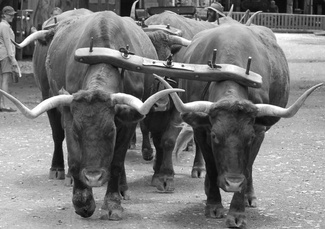Of course, we are talking about two very different traditions. Yoga is all about embodiment—one becomes a student of Yoga by feeling the experience of it in ones body. Judaism is also, very much, an experienced tradition—you can't just study Judaism, you have to live it—yet, there is very little emphasis in traditional Jewish texts on the way that the practice of Judaism feels in the physical body. From time to time, though, I see strong parallels in the way that Yoga and Judaism talk about their deepest experiences. The two traditions, it seems, have a lot to learn from each other.
One of the things that Yoga and Rabbinic Judaism have in common is the image of the yoke. A yoke—על (ol), in Hebrew—is used throughout rabbinic writing as a metaphor for the way in which we connect ourselves to God. The first paragraph of the Shema is called, Kabalat Ol Malchut Shamayim, the Acceptance of the Yoke of Heaven's Rule. This is the section that declares, "Hear O Israel, Adonai is our God, Adonai is One." The first step of observance, the rabbis state, is for us to submit ourselves to a singular God who is our sovereign. Without recognizing that there is something outside of ourselves that has the authority to dictate a moral code and pattern for our lives, there can be no meaningful connection to God. This acceptance is called a yoke because, like the collar that ties the ox to its fellow, to its master and to the plow, reciting the Shema ties us to each other, to God and to the work of repairing the world.
Once each of us accepts that we are not the center of the universe, we must take the next step and acknowledge the corollary: our actions have consequences. The second paragraph of the Shema is called Kabalat Ol Hamitzvot, the Acceptance of the Yoke of the Commandments. (Unfortunately, it is omitted from most Reform prayerbooks). The section states that observance of the mitzvot is connected to the fulfillment of the natural cycle of agriculture and the seasons. Living life as we are intended leads to plenty and satisfaction for all, but ignoring the right path leads to starvation and death. When we behave well, we promote joy; when we behave poorly, we promote suffering. Reciting the second paragraph of the Shema is a declaration that the way we choose to respond to the eternal moral code links us to God and to each other.
The word yoga in Sanskrit means "yoke," and Yoga uses the metaphor of the ol in ways that are similar to Rabbinic Judaism. Scott Feinberg, my amazing Yoga instructor, talked this week about the three-step path of a yogi. The first step is to yoke together the body, the mind and the breath. This is a simultaneous act of discipline and exploration in which one unites ones being in harmony with itself and with reality all around. It is a harnessing of the mind and spirit to the material reality of the body, and harnessing the material reality of the body to the varied and infinite possibilities of mind and spirit.
The second step is to yoke oneself to the Divine, however it may be understood. To be a yogi is to allow yourself awareness of the universal life force of which you are a part. It is a celebration of the gift of existence and the ability that we all have to shine brilliantly as a part of that miracle. The third step is to return to the material world, to recognize its limitation and its beauty, and to surrender to it.
There is no direct parallel between the way that Yoga describes its yokes and the way that Judaism describes its ulim—they are cousins, not siblings. Yet, the conversation between them is interesting. Rabbinic Judaism puts far more weight on the idea of "commandedness" than does Yoga. Judaism insists that "there is judgement and there is a Judge." It is not enough to perceive a yoke that ties us all together, says Judaism, we must also know that the yoke has authority over us. Judaism can teach Yoga that discipline does not just come from within; its origin is a commanding presence from beyond ourselves.
Yoga can teach Judaism that the yoke should not be viewed primarily as a burden, but as a joy. Putting on the yoke is first an act of harmonizing ourselves, not just stifling our evil impulses. By accepting the discipline of the Yoke of Heaven's Rule and the Yoke of the Commandments, we prepare ourselves to enter a new awareness of the Universal Life Force (חי העלמים, chei ha-olamim) in which we can shine brightly with our entire being—mind, body and spirit.


 RSS Feed
RSS Feed
